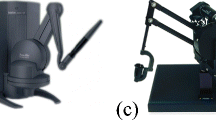Zusammenfassung
Assistant physicians typically learn surgical techniques by observation and supervised practice on the patient or using biophantoms. Alternatively, surgical simulators with the possibility of new training possibilities can be used. A number of simulators is already commercially available and might in the future become as important for surgical training as flight simulators. Since so far no simulator is concerned with the training of tracheotomies, a soft-tissue model for simulating tracheotomy was developed. This soft-tissue model is integrated into our ENT surgical simulator for tracheotomy. To model the soft-tissues of the neck (skin and fat), a computed tomography (CT) scan was interactively segmented. For the interaction simulation of a scalpel with the soft-tissue, position based dynamics (PBD) was used, originally developed for the gaming industries. Initial results imply that the proposed approach is able to model soft tissues for virtual surgical training.
Access this chapter
Tax calculation will be finalised at checkout
Purchases are for personal use only
Preview
Unable to display preview. Download preview PDF.
Similar content being viewed by others
Literatur
Kotsis S, Chung K. Application of see one, do one, teach one concept in surgical training. Plast Reconstr Surg. 2013;131(5):1194–1201.
Iverson K, Riojas R, Sharon D, et al. Objective comparison of animal training versus artificial simulation for initial cricothyroidotomy training. Am Surg. 2015;81(5):515–518.
Misra S, Ramesh K, Okamura A. Modeling of tool-tissue interactions for computerbased surgical simulation: a literature review. Presence. 2008;17(5):463–491.
Klemm E, Nowak AK. Tracheotomy-related deaths: a systematic review. Dt Ärzteblatt Int. 2017;114(16):273.
Franz D, Katzky U, Neuman S, et al. Haptisches Lernen für Cochlea Implantationen – Konzept. Proc’s CURAC. 2016; p. 21–26.
Eixelberger T, Wittenberg T, Perret J, et al. A haptic model for virtual petrosal bone milling. Proc’s CURAC. 2018; p. 214–219.
Pan J, Bai J, Zhao X, et al. Real-time haptic manipulation and cutting of hybrid soft tissue models by extended position-based dynamics. Comp Anim & Virt Worlds. 2015;26(3-4):321–335.
Berndt I, Torchelsen R, Maciel A. Efficient surgical cutting with position-based dynamics. IEEE Comput Graph Appl. 2017;37(3):24–31.
Lu Z, et al. Towards physics-based interactive simulation of electrocautery procedures using PhysX. IEEE Haptics Symposium. 2010; p. 515–518.
Bender J, Koschier D, Charrier P, et al. Position-based simulation of continuous materials. Comp & Graphics. 2014;44:1–10.
Zilles C, Salisbury J. A constraint-based god-object method for haptic display. Rep U S. 1995;3:146–151.
Picinbono G, Lombardo JC; Citeseer. Extrapolation: a solution for force feedback. Int Sci Workshop on Virt Real & Prototyping. 1999; p. 117–125.
Macklin M, Müller M, Chentanez N. XPBD: position-based simulation of compliant constrained dynamics. Proc ICMG. 2016; p. 49–54.
Author information
Authors and Affiliations
Corresponding author
Editor information
Editors and Affiliations
Rights and permissions
Copyright information
© 2020 Springer Fachmedien Wiesbaden GmbH, ein Teil von Springer Nature
About this paper
Cite this paper
Eixelberger, T., Parchent, J., Janka, R., Stamminger, M., Döllinger, M., Wittenberg, T. (2020). Haptic Rendering of Soft-Tissue for Training Surgical Procedures at the Larynx. In: Tolxdorff, T., Deserno, T., Handels, H., Maier, A., Maier-Hein, K., Palm, C. (eds) Bildverarbeitung für die Medizin 2020. Informatik aktuell. Springer Vieweg, Wiesbaden. https://doi.org/10.1007/978-3-658-29267-6_76
Download citation
DOI: https://doi.org/10.1007/978-3-658-29267-6_76
Published:
Publisher Name: Springer Vieweg, Wiesbaden
Print ISBN: 978-3-658-29266-9
Online ISBN: 978-3-658-29267-6
eBook Packages: Computer Science and Engineering (German Language)




